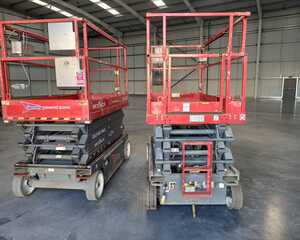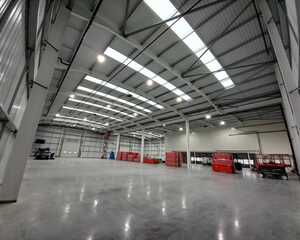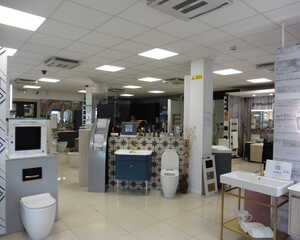
Lighting plays a critical role in commercial and industrial environments. The type of lighting you choose affects how well a space functions, how safe it is to work in, and how much energy your business uses.
In settings like warehouses, workshops, showrooms and factories, choosing between high bay and low bay lighting is a decision that should be based on the layout and scale of your premises.
Understanding the technical and practical differences between the two will help you make a well-informed choice.
What defines high bay lighting?
High bay lighting is designed for buildings with tall ceilings. It’s most suitable for spaces where the mounting height is 6 metres or more. These types of fittings produce strong, controlled beams of light to ensure even distribution across large floor areas. They’re typically found in warehouses, logistics hubs, aircraft hangars, production facilities and sports halls.
High bay lights need to project light efficiently from height without causing dark spots, glare or shadows. For this reason, they’re designed with narrow or medium beam angles and high lumen output. This ensures light reaches working surfaces effectively, even in buildings with significant vertical space or complex racking layouts.
Modern high bay LED fittings often include microwave sensors, which detect movement and ambient light. This allows the lights to dim or switch off automatically when the area is unoccupied or naturally well lit, reducing wasted energy.
Where low bay lighting is a better fit
Low bay lighting is suited to rooms or buildings with ceiling heights of around 2.5 to 5 metres. These fittings spread light more broadly, with a wider beam angle, to prevent over-lighting and glare at eye level. They’re commonly used in retail units, small workshops, garages, classrooms, stairwells and showrooms.
Because the distance between the light source and working area is shorter, low bay fittings don’t need the same level of intensity as high bay lights. Instead, they focus on providing a consistent, comfortable light spread that supports visibility without being harsh or uneven.
Low bay lighting can also benefit from smart sensor integration, particularly in spaces with intermittent use such as store rooms, corridors or customer areas.

Ceiling height is the key decision point
The height of your ceiling is the primary factor that determines whether you need high bay or low bay lighting. If the fixtures are installed too high or too low for the space, light levels will suffer. You may end up with areas that are either too dim to work safely or over-lit to the point of discomfort and energy waste.
Fitting low bay lights in a tall warehouse, for example, may leave aisles in partial shadow, especially near the floor or shelving. Similarly, installing high bay lights in a small retail unit may create sharp brightness and visual fatigue for staff or customers.
If your ceiling height falls somewhere in the middle – around 5 to 6 metres – then the intended use of the space becomes the deciding factor. Precision work or vertical storage may benefit more from high bay fittings, while wider open-plan layouts may suit low bay fittings with a broader spread.
Light quality and lux levels
Different tasks require different light levels, measured in lux. Warehouses, for instance, typically need between 150 and 300 lux, while detailed manufacturing may require 500 lux or more. Office areas and retail spaces usually work best between 300 and 500 lux, depending on the layout and screen use.
High bay lighting can deliver these levels over larger areas, while low bay fittings are optimised for smaller zones. Getting the specification right from the outset ensures compliance with Health and Safety Executive (HSE) guidelines and contributes to a more productive and comfortable environment.

Beam angles and optics
Further differences between the two types come in the form of beam angles. High bay fixtures tend to have narrower beams – often 60° to 90° – to direct light downwards from height. Low bay fixtures use wider angles – 90° to 120° or more – to spread light evenly across a room.
The right optics help reduce shadows, improve visibility and ensure energy is not wasted lighting areas that don't need it. This is particularly important in environments with racking, shelving or partitioned work zones.
Energy efficiency and long-term savings
Both high bay and low bay LED lighting offer excellent energy efficiency when specified correctly. The true savings, however, come from matching the right type of fixture to the space. Oversized or misplaced fittings will use more power than necessary. Underpowered ones may lead to increased quantities of lights being installed to compensate, driving up installation and maintenance costs.
The most efficient systems use smart microwave sensors and daylight harvesting to regulate output in real time. This ensures that lights operate only when needed, significantly reducing running costs over time. With build lifespans of up to 100,000 hours, many of these LED solutions are also virtually maintenance free.
Getting expert support
If you’re unsure which type of lighting is right for your building, a professional lighting survey is a smart place to start. At LED Lights 4 You, we carry out free site surveys to assess ceiling heights, layout, existing fixtures, and your current energy usage. We then produce a lighting report showing recommended lux levels, projected savings, and the most suitable high or low bay products for your environment.
By combining technical design with real-world use cases, we help businesses across the UK upgrade their lighting systems with confidence.
Posted by Paul on October 27th 2025

